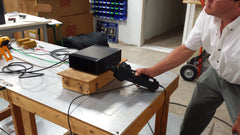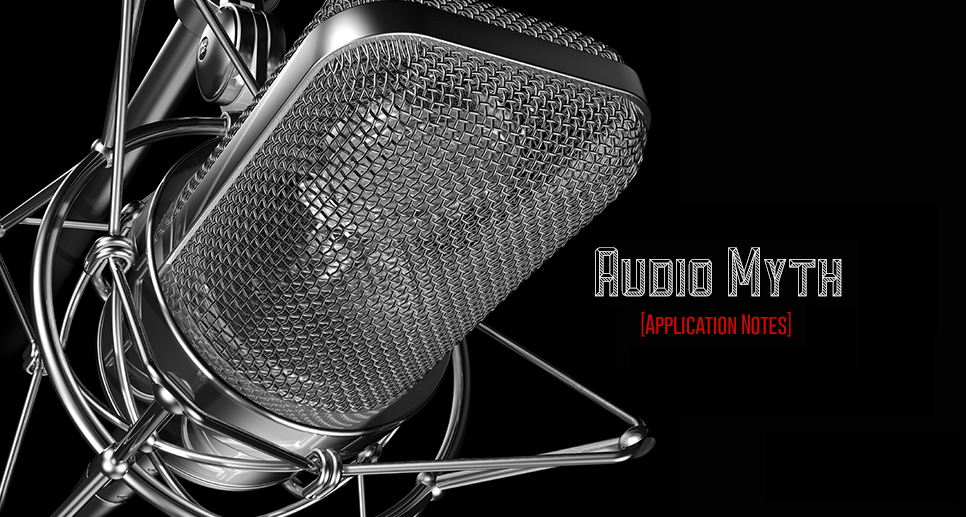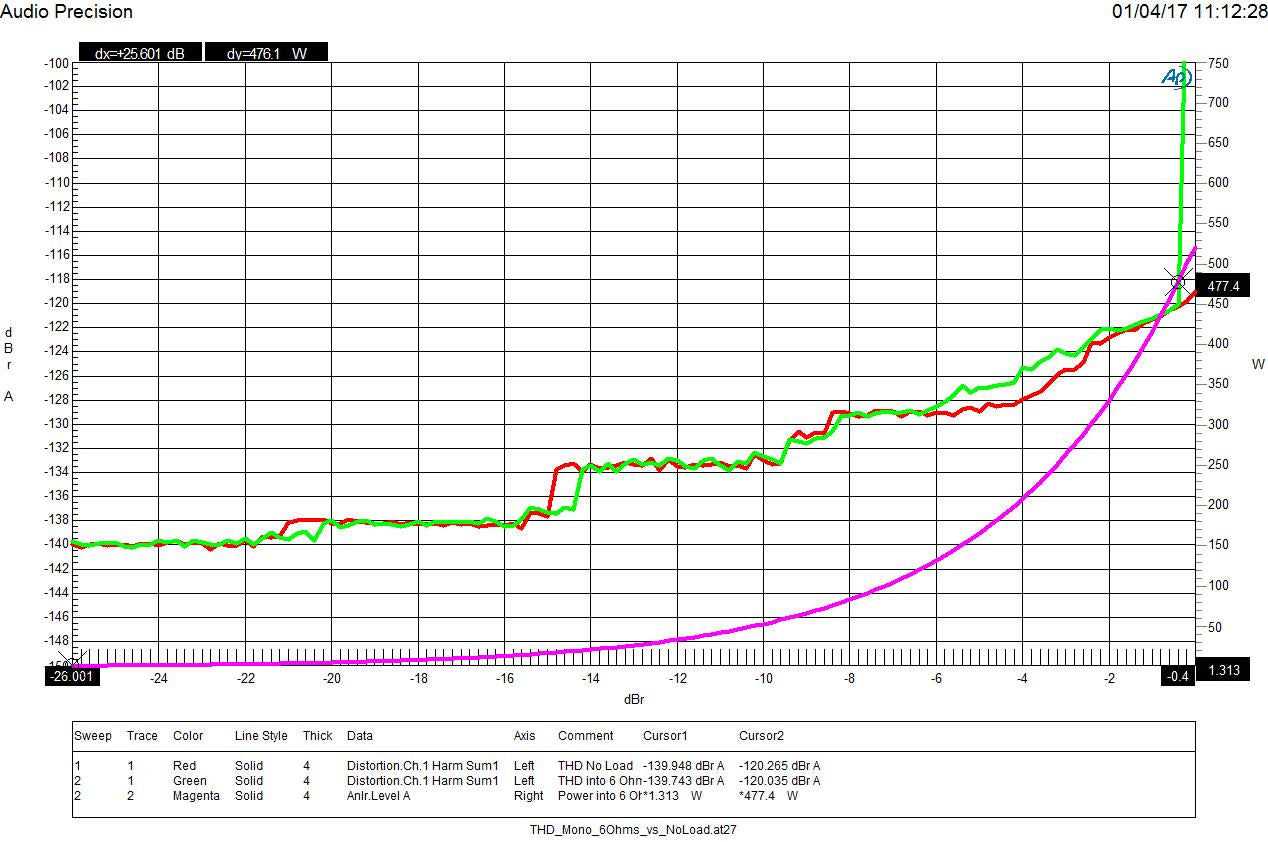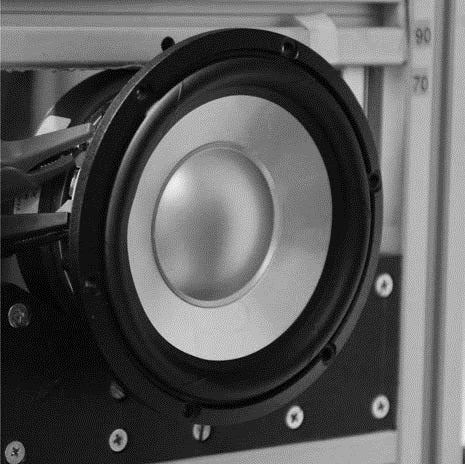Buy one component and save 10% on up to 2 cables. Buy 2 components and get 4 free cables. Free shipping on USA orders over $700.
Buy one component and save 10% on up to 2 cables. Buy 2 components and get 4 free cables. Free shipping on USA orders over $700.
Audio Application Notes
How Loud is the Distortion from Your Power Amplifier?
by John Siau August 08, 2025
Would you put a Washing Machine in your Listening Room?
If the answer is no, you may be surprised to discover that the distortion produced by your power amplifier may be louder than the noise produced by a major appliance.
Don't believe me? Take a look at Stereophile's test reports:
We selected 7 power amplifiers from Stereophile's top list of recommended amplifiers.
We took Stereophile's "THD+N vs. Power" plots for each, and replotted the data in a format that shows the loudness of the THD+N at the listening position.
The results are shocking!
Amplifier THD+N is louder than expected!
The distortion from your amplifier may be louder than a washing machine on the spin cycle, or it may be totally silent. How does yours perform? The answer is hidden in Stereophile's THD+N plots.
This application note reveals the hidden truth:
"The Distortion from your Power Amplifier may be Louder than a Washing Machine!"
I know, it sounds crazy, but this is what the measurements show!
Secrets Q&A with John Siau of Benchmark Media Systems
by Benchmark Media Systems January 07, 2022
Secrets contributor Sumit Chawla recently caught up with Benchmark’s VP and Chief Designer, John Siau to get a little more in-depth on several subjects.

Q: "Benchmark is one of the few companies that publishes an extensive set of measurements, but you also balance that with subjective testing. Can you talk about the equipment, the listening room, and the process for subjective testing?"
Q: "Was there ever a time where you learned something from a subjective test that was not captured by measurements?"
Q: "You conducted some listening tests to determine whether distortion in the “First Watt” was audible. What test material did you use for this, and what did you find?"
Q: "The AHB2 amplifier incorporates THX Audio Achromatic Amplifier technology. When and how did the partnership with THX come about?"
Q: "Linear power supplies have been and remain quite popular in high-end devices. You favor switch-mode power supplies. When and why did you make this switch?"
... and more!
Audio Myth - "Damping Factor Isn't Much of a Factor"
by John Siau June 04, 2020
Myth - "Damping Factor Isn't Much of a Factor"
Myth - "A Damping Factor of 10 is High Enough"
Myth - "All Amplifiers Have a High-Enough Damping Factor"
Where did these Myths Originate?
These myths seem to trace back to a well-know paper written by Dick Pierce. His analysis shows that a damping factor of 10 is virtually indistinguishable from a damping factor of 10,000 when it comes to damping the motion of a loudspeaker cone. This analysis has been examined and repeated in many more recent articles, such as a well-written post on Audiofrog.com by Andy Wehmeyer. Articles such as these are often cited as evidence that amplifier damping factor doesn't matter. The mathematical analyses are correct, but the conclusions are incomplete and misleading!
Feed-Forward Error Correction
by John Siau October 11, 2018
The Benchmark AHB2 power amplifier and HPA4 headphone amplifier both feature feed-forward error correction. This correction system is an important subset of the patented THX-AAA™ (Achromatic Audio Amplifier) technology. It is one of the systems that keeps these Benchmark amplifiers virtually distortion free when driving heavy loads. It is also the reason that these amplifiers can support 500 kHz bandwidths without risk of instability when driving reactive loads.
This paper explains the differences between feedback and feed-forward systems. As you read this paper, you will discover that you already understand the benefits of feed-forward correction because you use it instinctively to improve a feedback system commonly found in your automobile. If feed-forward correction can improve your driving experience, it may also improve your listening experience!
- John Siau
Laboratory Use of the Benchmark AHB2 Power Amplifier
by John Siau January 26, 2018
SEAS, a well-known manufacturer of high-quality loudspeakers, selected the Benchmark AHB2 as a key component for use in testing loudspeakers. They created an innovative test system that measures loudspeaker motor strength and moving mass with higher accuracy than previous methods. This new measurement system was documented in the December 2017 Journal of the Audio Engineering Society.
According to the AES paper, the SEAS team selected the Benchmark AHB2 for the following reasons:
"A Benchmark AHB2 amplifier is used, which has excellent signal-to-noise ratio and bandwidth, low output impedance, and is suitable for laboratory use (with advanced overload protection)."
The AHB2 was designed to outperform all competing power amplifiers in terms of noise and distortion. The result is an amplifier with unrivaled transparency.
Our goal was to create the ultimate amplifier for the enjoyment of music. It is nice to know that the AHB2 is also being used to test new and improved loudspeakers!
- John Siau
Interpreting THD Measurements - Think dB not Percent!
by John Siau November 15, 2017
Distortion measurements (THD, THD+N and IMD) are traditionally expressed in terms of percent. But what do 1%, 0.1%, 0.01% or 0.001% mean in terms of loudness or audibility?
If you are like most people you just know that 0.001% is the best of the three numbers listed above. If you are a well-trained geek you will recognize that each added leading zero represents a 20 dB improvement. 0.01% is 20 dB lower than 0.1% and 40 dB lower than 1%. The well-trained geek will convert % to dB in order to give meaning to these numbers.
When THD is expressed in terms of dB, we can easily determine how loud the distortion will be in our playback system.
Will my audio electronics produce audible distortion?
Will the distortion produced by my audio electronics be inaudible?
- John Siau
Calculating the Performance of an Amplifier-Speaker Combination - Example 2
by John Siau October 27, 2017
Example 2 - PMC MB2S
In this application note we calculate the maximum output level and noise level produced by an amplifier/loudspeaker combination.
This application note can serve as an example for calculating the maximum sound pressure levels and noise output levels for any amplifier/speaker combination.
At the 143rd AES conference in NYC, we demonstrated two Benchmark AHB2 monoblock power amplifiers driving a pair of 4-Ohm PMC MB2S studio monitors.
We were extremely impressed by the unusually clean, distortion-free, output of these monitors. They fully compliment the distortion-free performance of the AHB2 to provide a system with outstanding clarity while delivering high sound pressure levels.
In this application note we will calculate the peak SPL produced by this system. We will also calculate the acoustic noise at a distance of 1 meter from each monitor. We will also discuss some of the unique design features of the MB2S monitors that contribute to their impressive performance.
- John Siau
Speaker Sensitivity and Amplifier Power
by John Siau April 27, 2017
Speaker sensitivity is a measure of how loud a speaker will play at a given input power or at a given input voltage. Sensitivity is normally measured with a 1 watt power input or a 2.83 Vrms voltage input.
There have been many different speaker designs over the years and there are vast differences in speaker sensitivity. The speakers below have sensitivities ranging from about 85 dB to 109 dB.
- What are the power requirements?
- What are the implications for system noise?
- How loud will each play?
- Do they require different amplifiers?
- John Siau
Calculating the Performance of an Amplifier-Speaker Combination
by John Siau November 01, 2016
Example 1 - PMC IB2S
In this application note we calculate the maximum output level and noise level produced by an amplifier/loudspeaker combination. Use this example for calculating the performance of your system.
At the 141st AES conference we demonstrated two Benchmark AHB2 monoblock power amplifiers driving a pair of 4-Ohm PMC IB2S studio monitors. These monitor are also available the PMC IB2SE hi-fi version.
In bridged mono, the AHB2 can deliver over 518 watts into each of these 4-Ohm speakers. This is a perfect match to PMC's 500 watt recommendation. The AHB2 easily provides the power, the output current, and the damping required by these low-impedance speakers.
"I am very impressed with the clarity and accuracy of these outstanding professional monitors. The Benchmark AHB2 and PMC IB2S are an absolutely killer combination!"
- John Siau, VP, Benchmark Media Systems, Inc.
Power Amplifiers - A "First Watt" ABX Test
by John Siau September 27, 2016
In Benchmark's listening room we recently demonstrated the importance of the first watt using two 100 watt stereo power amplifiers. One amplifier was a traditional class-AB amplifier, the other was Benchmark's AHB2 power amplifier with feed-forward error correction. Using a double-blind ABX test, we verified that there was a clearly audible difference when the amplifiers drove speakers at an output level of 0.01 watt.
- John Siau
Audio Myth - "Switching Power Supplies are Noisy"
by John Siau May 03, 2016
This Myth Goes Something Like This:
"Switching supplies are noisy."
"Linear power supplies are best for audio."
We disagree!
About 5 years ago, Benchmark stopped putting linear power supplies into our new products, and we replaced them with switching power supplies. We did this because linear supplies are too noisy. Yes, you read that correctly, linear supplies are noisy!
A well-designed switching power supply can be much quieter than a linear supply!
Find out why!
- John Siau
Crossover Distortion - Video Clip
by John Siau March 14, 2016
The AHB2 - A new and radically different audio power amplifier! Dick Olsher once said that "the first Watt is the most important Watt".
This short 8-second video clip demonstrates some of the differences.
- John Siau
AHB2 Crossover Distortion Measurements
by John Siau March 10, 2016
Crossover Distortion - Measurements
The following measurements and scope photos demonstrate the effectiveness of the feedforward system in the AHB2.
From the first Watt to the last Watt, the AHB2 shows no evidence of crossover distortion. In contrast, all conventional class-AB amplifiers have crossover-distortion artifacts.
Dick Olsher once said that "the first Watt is the most important Watt". I agree!
- John Siau
Amplifier Crossover Distortion
by John Siau March 10, 2016
Crossover Distortion - Introduction
Most audio power amplifiers suffer from a defect known as "crossover distortion". This distortion is particularly troublesome at low output levels. At low power levels, the crossover distortion can rise to a high percentage of the output level and become the dominant source of distortion.
- John Siau
The HPA2™ Headphone Power Amplifier
by John Siau July 22, 2015
Why do I need a Power Amplifier to Drive My Headphones?
Many Benchmark products include our HPA2™ headphone power amplifier. Unlike most headphone amplifiers, the HPA2™ is designed to behave like a small but very clean power amplifier. What makes the HPA2™ different, and what do we mean when we say that the HPA2™ is a "power amplifier"?
- John Siau
What High-Resolution Audio is NOT
by John Siau August 27, 2014
"Low-Resolution Hardware Cannot Deliver High-Resolution Audio"
The music industry is struggling to define High-Resolution Audio or "HRA". In doing so, most have focused on the delivery formats - analog vs. digital, 24-bits vs. 16-bits, 1X vs. 2X and 4X sample rates, PCM vs. DSD, uncompressed vs. compressed.
But, High-Resolution Audio is much more than the delivery format ...
"High-Resolution Audio Requires High-Resolution Performance at all Stages of the Recording and Playback Chain"
- John Siau
The AHB2 - A Radical Approach to Audio Power Amplification
by John Siau July 30, 2014
 Radical!
Radical!

The performance of the AHB2 would not have been achievable without taking a radical approach to power amplification. In many ways, the AHB2 is a complete 180 degree departure from traditional high-end amplifier designs. There is nothing ordinary about the Benchmark AHB2! It is also not a class-D amplifier!
Take a look inside this unique linear audio power amplifier!

The CE Mark - A Photo-Tour of Immunity Testing
by John Siau June 25, 2014
Testing for Immunity to Interference

- John Siau























